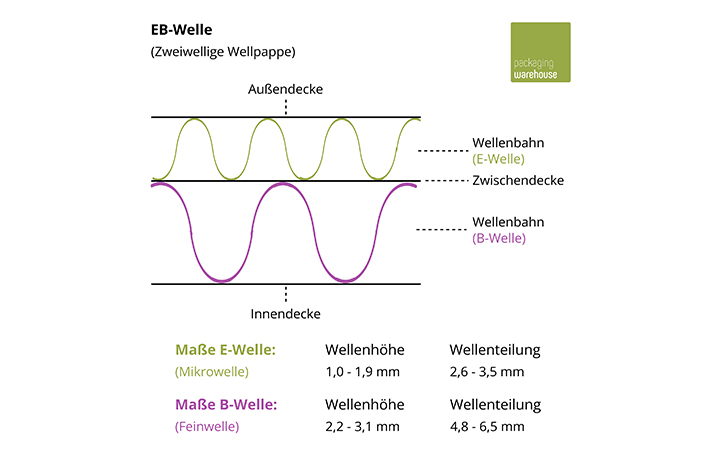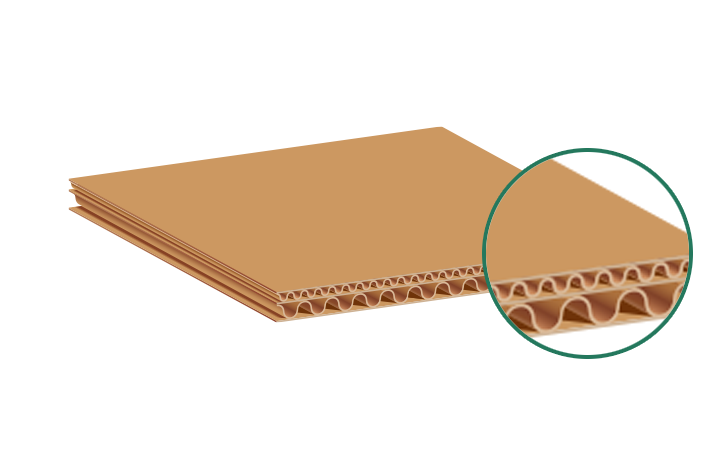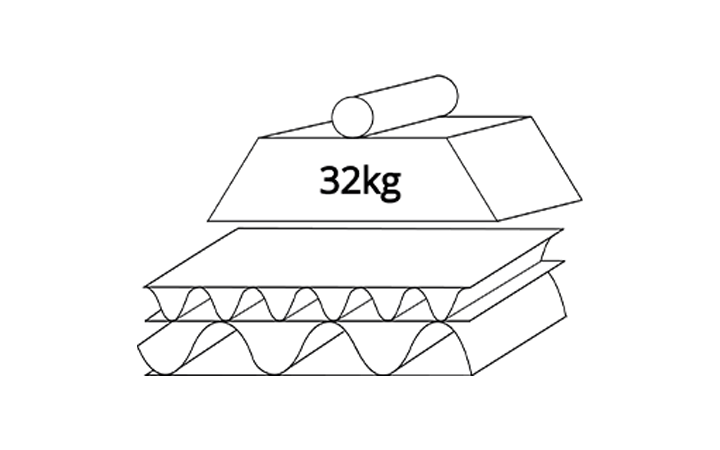Your boxes made of EB-flute:
- Double flute carton made of high quality corrugated cardboard
- High stability and excellent printing properties
- Load capacity up to 32 kilograms with even weight distribution
 Folding boxes
Folding boxes
 (1).png) Folding box with tuck-in flap
Folding box with tuck-in flap
 (1).png) Folding box with snap lock base
Folding box with snap lock base
 (1).png) Folding box with crash lock base
Folding box with crash lock base
.png) Folding boxes made of corrugated cardboard
Folding boxes made of corrugated cardboard
.png) Folding box with Euro slot hanger
Folding box with Euro slot hanger
.png) Folding box with hinged lid
Folding box with hinged lid
.png) Folding boxes with safety flap
Folding boxes with safety flap
 Inlay / cardboard insert
Inlay / cardboard insert
.png) Counter display
Counter display
.png) Gable box
Gable box
 Carry handle box
Carry handle box
 Pillow box
Pillow box
 Folding box with separator
Folding box with separator
 Cardboard slipcase as banderole
Cardboard slipcase as banderole
 Euro slot hanger
Euro slot hanger
 Flat cardboard sleeve
Flat cardboard sleeve
 Reinforcing inlay made of corrugated cardboard
Reinforcing inlay made of corrugated cardboard
 Shipping boxes
Shipping boxes
.png) Hinged boxes
Hinged boxes
.png) Hinged lid boxes with adhesive strips
Hinged lid boxes with adhesive strips
 Hinged lid box with adhesive strip - free format
Hinged lid box with adhesive strip - free format
 Shipping carton with adhesive strip and crash lock base
Shipping carton with adhesive strip and crash lock base
 Large letter box | 340 x 240 x 15 mm
Large letter box | 340 x 240 x 15 mm
 Maxi letter box | 280 x 200 x 40 mm
Maxi letter box | 280 x 200 x 40 mm
 Maxi letter box | 340 x 240 x 45 mm
Maxi letter box | 340 x 240 x 45 mm
 DHL parcel S | 250 x 150 x 90 mm
DHL parcel S | 250 x 150 x 90 mm
 DHL parcel S | 340 x 240 x 90 mm
DHL parcel S | 340 x 240 x 90 mm
 DHL parcel M | 340 x 210 x 140 mm
DHL parcel M | 340 x 210 x 140 mm
 DHL parcel M | 450 x 320 x 100 mm
DHL parcel M | 450 x 320 x 100 mm
 Folding carton - FEFCO 0201
Folding carton - FEFCO 0201
 Shipping carton with adhesive strip and crash lock base
Shipping carton with adhesive strip and crash lock base
.png) Folding boxes made of corrugated cardboard
Folding boxes made of corrugated cardboard
 Cardboard slipcase - FEFCO 0503
Cardboard slipcase - FEFCO 0503
 Inlay / cardboard insert
Inlay / cardboard insert
 Cardboard blank FEFCO 0110
Cardboard blank FEFCO 0110
 Reinforcing inlay made of corrugated cardboard
Reinforcing inlay made of corrugated cardboard
 Stand-up pouch & flat pouch
Stand-up pouch & flat pouch
 Stand-up pouches - individual size
Stand-up pouches - individual size
.png) Stand-up pouches by material
Stand-up pouches by material
.png) PP monofilm white - ♻️
PP monofilm white - ♻️
 PP monofilm white - ♻️
PP monofilm white - ♻️
 PP monofilm transparent - ♻️
PP monofilm transparent - ♻️
 PP monofilm metallised - ♻️
PP monofilm metallised - ♻️
 PE monofilm transparent - ♻️
PE monofilm transparent - ♻️
 PE monofilm white - ♻️
PE monofilm white - ♻️
 Our material finder
Our material finder
 Composite film transparent
Composite film transparent
 Composite film white
Composite film white
 Composite film metallic silver
Composite film metallic silver
 Composite film white with Aluminium
Composite film white with Aluminium
 Natural paper brown + PE
Natural paper brown + PE
 Natural paper white + PE
Natural paper white + PE
.png) Flat pouches
Flat pouches
 PP monofilm transparent - ♻️
PP monofilm transparent - ♻️
 PP monofilm white - ♻️
PP monofilm white - ♻️
 PP monofilm metallised - ♻️
PP monofilm metallised - ♻️
 PE monofilm transparent - ♻️
PE monofilm transparent - ♻️
 PE monofilm white - ♻️
PE monofilm white - ♻️
 Flat pouch made of transparent PET/PE film
Flat pouch made of transparent PET/PE film
 Our material finder
Our material finder
 Flat pouch made of white PET/PE film
Flat pouch made of white PET/PE film
 Flat pouch made of metallic PETmet/PE film
Flat pouch made of metallic PETmet/PE film
 Flat pouch made of brown paper + PE
Flat pouch made of brown paper + PE
 Flat pouch made of white paper + PE
Flat pouch made of white paper + PE
 Our material finder
Our material finder
 Stand-up pouch 100 ml
Stand-up pouch 100 ml
 Stand-up pouch 250 ml
Stand-up pouch 250 ml
 Stand-up pouch 500 ml
Stand-up pouch 500 ml
 Stand-up pouch 750 ml
Stand-up pouch 750 ml
 Stand-up pouch 1000 ml
Stand-up pouch 1000 ml
 Stand-up pouch 1500 ml
Stand-up pouch 1500 ml
 Roll labels
Roll labels
 Membrane cans
Membrane cans
 Gift boxes
Gift boxes







.png)




Corrugated cardboard comes in many different types. The main distinguishing feature is the height of the respective corrugations and their distance from each other. This is also referred to as corrugation height and corrugation spacing. In general, the corrugated cardboard classes are divided into the categories mini, fine, medium, coarse and imperial flute.
While the smallest category, the so-called mini flute, has a flute height of 0.4 to 0.6 mm and a flute separation of 1.6 to 1.8 mm, the largest corrugated cardboard category, the imperial flute, has a flute height of over 5 mm and a flute separation of at least 10 mm..
This means that a fine flute has much smaller air cushions than a coarse or imperial flute. This results in a lower load-bearing capacity, but in return a more even surface. The imperial flute has a very high load-bearing capacity, but is more difficult to print on due to the larger gaps and the resulting uneven surface.
Due to the different characteristics, the different categories of corrugated cardboard have different advantages and therefore are used differently.
Corrugated cardboard with high flutes and with greater spacing have large air cushions and therefore also very high stability. Therefore, they are suitable for transporting heavy goods and are primarily used as pure transport packaging.
Smaller flutes, such as the E-flute, are preferably used as product packaging for light goods. Here they have a decisive advantage over the larger flutes: Due to the smaller air cushions in the material, the surface structure is very uniform. This factor comes into play especially when the corrugated cardboard is to be printed, which is usually the case with product packaging.
This is because dents and deformations ensure that the print image can not be printed on the cardboard without errors. On the other hand, the unevenness causes it to be deformed and not to appear as desired. But what if you need product packaging that has to have a high load-bearing capacity on the one hand and good printability on the other?


Double flute corrugated cardboard is the perfect solution for this application. As the name suggests, two single flute cartons are glued together to form a double flute carton. While the flute with the larger air cushions is used as the inner layer due to its stability and protective properties, the smaller flute is used as the outer layer to ensure good printing properties of the carton.
The manufacturing process is quite simple: both flutes are glued together with an intermediate sheet. This results in a new cardboard box, the name of which is also made up of the combination of the two flutes.
The EB-flute has a load-bearing capacity of up to 32 kg and, thanks to its pressure properties, is very well suited as product packaging for heavier goods. One example is bottle containers that need to be transported safely but presented attractively.
Another area of application are, for example, moving boxes. Here, however, the focus is not on printability, but on high stability with very low own weight. They increase the weight of the goods to be transported only minimally, but are very stable and can be stacked well on top of each other.


One of the most popular and most requested flute combinations is that of the E-flute with the B-flute. The finished product is called EB-flute.
Here, the B-flute with its flute height of 2.2 to 3.1 mm and a flute separation of 4.8 to 6.5 mm is used as a stable inner wall. The E-flute is used as a good printable outer wall due to its lower flute height of 1.0 to 1.9 mm and a flute separation of 2.6 to 3.5 mm. Both flutes are glued together with an intermediate sheet to form a single unit.
The result is a cardboard that combines the best of both flutes: high load-bearing capacity and a smooth surface that is ideal for printing.








